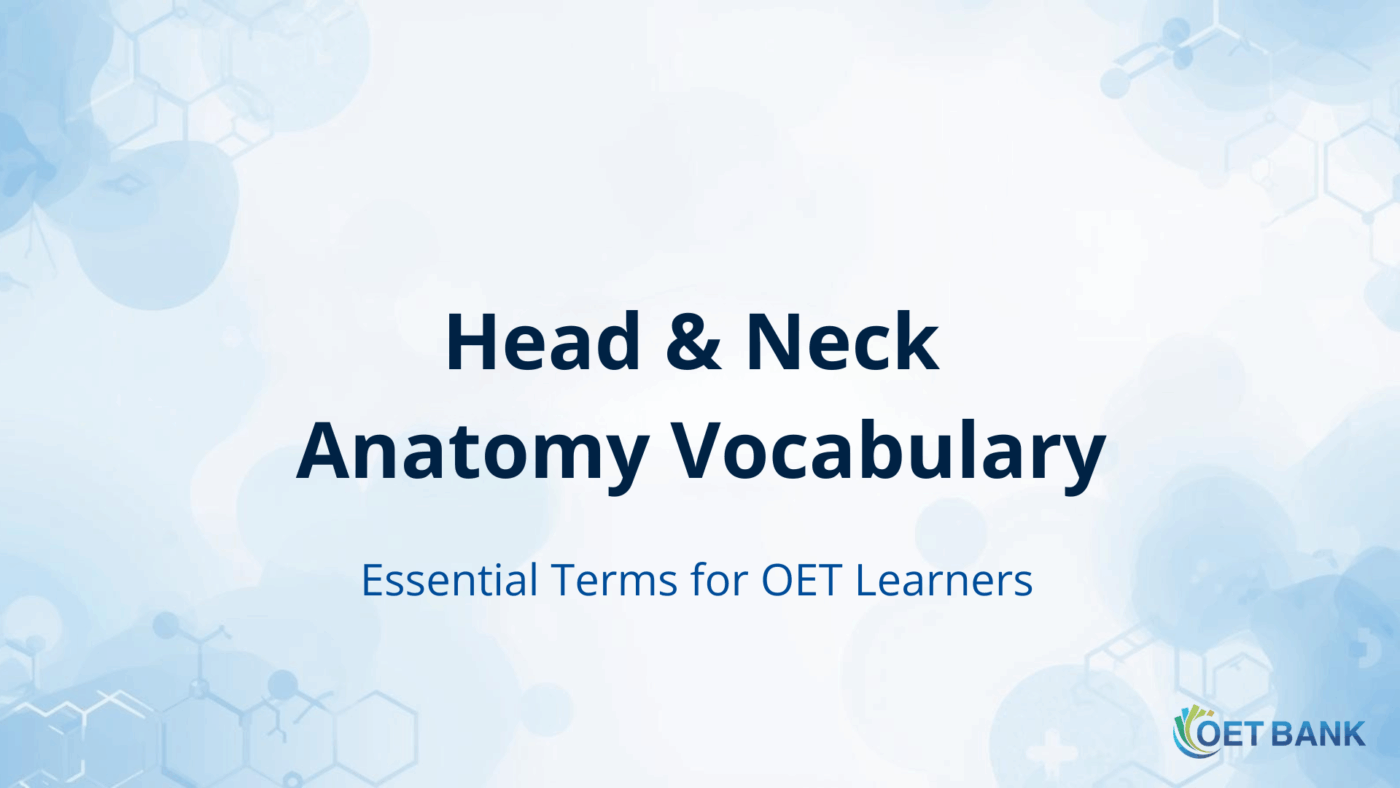Anatomy & Body Regions, OET Vocabulary
OET Must-Know Vocabulary: Head & Neck Anatomy
Understanding head and neck anatomy terms is essential for OET Speaking, Listening, and real clinical communication.
Below is a quick, simple reference you can study anytime. Start with the short video, then review the list of key terms with OET-style example sentences.
Head & Neck Vocabulary List (with OET Examples)
Back & Side of the Head
Occiput – Back of the head
Example (clinical note): “Tenderness is noted over the occiput following the fall.”
Temple – Side of your head between eye and ear
Example (patient complaint): “I feel a sharp throbbing pain around my left temple.”
Scalp – Skin covering the top of the head
Example (clinical note): “The scalp shows mild swelling but no open wound.”
Forehead & Eye Area
Forehead – Area above your eyebrows
Example (exam): “The forehead is warm to touch with no visible rash.”
Glabella – Smooth area between eyebrows
Example (clinical note): “Pressure over the glabella reproduces the patient’s discomfort.”
Eyebrow – Hair line above the eye
Example (patient complaint): “It feels tender just above my eyebrow when I press here.”
Eyelid – Fold of skin that protects the eye
Example (clinical note): “The upper eyelid appears swollen and slightly erythematous.”
Cilium – Eyelash protecting the eye
Example (clinical note): “One cilium is turned inward, causing irritation.”
Oculus – The eyeball, organ of vision
Example (exam): “The oculus moves normally in all directions.”
Pupil – Black part that controls light
Example (clinical note): “The pupils are equal and reactive to light.”
Cheeks, Skin, and Nose
Dimple – Small hollow on the cheek
Example (general): “The patient has a natural dimple on the right cheek.”
Bucca – Cheek area beside the mouth
Example (clinical note): “There is mild swelling over the left bucca.”
Lentigo – Small dark spot on the skin
Example (clinical note): “A single lentigo is present without suspicious changes.”
Dorsum of nose – Bridge of the nose
Example (clinical note): “Bruising is visible along the dorsum of the nose.”
Ala of nose – Outer sides of the nostrils
Example (exam): “The right ala of the nose appears inflamed.”
Nostril – Opening of the nose for air
Example (patient complaint): “I can’t breathe well through my left nostril.”
Mouth & Lower Face
Gingiva – Gums supporting the teeth
Example (clinical note): “The gingiva around the molars is slightly swollen.”
Lip – Soft edge of the mouth
Example (clinical note): “The lower lip has a small superficial cut.”
Jaw – Bone forming the lower face
Example (patient complaint): “My jaw feels stiff when I wake up.”
Beard – Hair on chin and cheeks
Example (general): “The patient recently trimmed his beard.”
Mentum – Tip of the chin
Example (clinical note): “There is mild tenderness at the mentum after the impact.”
Neck & Throat Area
Throat – Passage for air and food
Example (patient complaint): “It hurts to swallow; my throat feels very sore.”
Laryngeal prominence – Adam’s apple
Example (exam): “The laryngeal prominence moves normally on swallowing.”
Sternocleidomastoid – Neck-turning muscle
Example (clinical note): “The sternocleidomastoid is tight on the right side.”
Nucha – Back of the neck
Example (patient complaint): “I feel stiffness along the nucha, especially in the morning.”
🌍 Study with OET Bank
Strong English skills are essential for success in healthcare communication.
At OET Bank, we strengthen your medical English through our original learning materials,
designed specifically for international healthcare professionals who want to use English confidently in real clinical settings.
👉 Discover OET Bank learning materials
https://oet-bank.com/shop/


